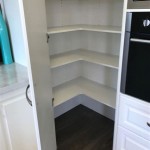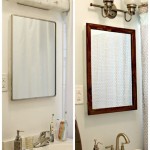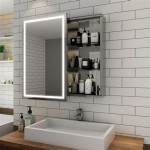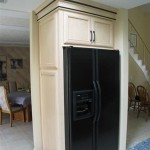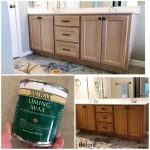Decoding the Optimal Handle Placement on Cabinet Doors
The strategic placement of handles on cabinet doors is a significant factor influencing both the aesthetic appeal and functional usability of kitchens, bathrooms, and other spaces with cabinetry. While seemingly a minor detail, proper handle placement contributes substantially to the overall design harmony and ergonomic efficiency of the cabinetry. Neglecting this aspect can result in an awkward, visually disjointed, and potentially uncomfortable user experience. This article will explore the principles and considerations that guide effective handle placement on cabinet doors.
Understanding the Fundamentals of Aesthetically Pleasing Handle Placement
Visual balance and proportion are paramount when determining handle placement. Cabinets are often a dominant element in a room's design, and the position of the hardware directly impacts the visual rhythm. Deviations from established norms can create a distracting and unsettling effect. The goal is to achieve a sense of harmony between the handle, the cabinet door, and the surrounding environment. This section will delve into the specific factors that contribute to this aesthetic balance.
The size of the cabinet door plays a crucial role. Smaller doors, typically those found on upper cabinets or narrow base units, benefit from handles positioned closer to the top or bottom edge, respectively. This proportionality ensures the handle doesn't overwhelm the door's surface. For larger doors, particularly those on full-height pantry cabinets or wide drawers, placing the handle closer to the center, or slightly above, often provides a more visually balanced and easier-to-access point of contact.
Cabinet style is another determining factor. Traditional cabinet designs often feature ornate handles or knobs positioned in a more decorative manner, sometimes closer to the door's edges to accentuate detailing or framing. Modern cabinet styles, conversely, frequently embrace minimalist hardware with placement emphasizing clean lines and functionality. The handle style and finish should complement the overall aesthetic of the cabinet and the room, ensuring cohesion and visual appeal.
Symmetry is a powerful tool in achieving visual harmony. In situations where cabinetry runs along a wall or features multiple doors, maintaining consistent handle placement across all doors creates a unified and visually pleasing effect. This consistency helps the eye flow smoothly across the cabinetry, enhancing the sense of order and balance within the space. However, adherence to strict symmetry should not compromise ergonomic accessibility.
Ultimately, the aesthetic placement of handles involves a balance between following established guidelines and exercising design intuition. While rules of thumb exist, the specific dimensions of the space, the style of the cabinetry, and the overall desired aesthetic should all inform the final decision. It is often beneficial to visually mock up different handle placements using tape or temporary adhesives to assess the impact before drilling any holes.
Prioritizing Ergonomics and Functionality in Handle Placement
Beyond aesthetics, the primary purpose of a cabinet handle is to facilitate easy and comfortable access. Ergonmically sound handle placement minimizes strain and effort when opening and closing doors, particularly for individuals with mobility limitations or those performing repetitive tasks. This section explores the principles of functional handle placement designed to enhance user experience.
Reach is a critical consideration. The handle should be positioned at a height that is easily accessible for the majority of users. For upper cabinets, this generally means placing the handle towards the bottom portion of the door, allowing users to comfortably reach up and grip the handle without excessive stretching or straining. For lower cabinets, handle placement should be higher, reducing the need to bend over excessively.
Grip strength and hand size also influence optimal handle placement. Handles that are too small or poorly shaped can be difficult to grip, especially for individuals with arthritis or limited hand strength. Selecting handles with a comfortable grip and adequate clearance for fingers is crucial. Furthermore, the distance between the mounting holes on the handle (center-to-center measurement) impacts the leverage provided when opening the door. Longer handles generally provide greater leverage, making it easier to open heavier or stiffer doors.
The type of handle chosen also affects functionality. Pulls, which are grasped with the entire hand, generally require less force to operate than knobs, which require a pinching motion. For individuals with limited hand strength, pulls are often a more ergonomic choice. The orientation of the handle (vertical or horizontal) can also impact usability. Vertical pulls on upper cabinets can be easier to grip, while horizontal pulls on drawers can provide a more natural hand position.
Consideration should be given to the swing direction of the cabinet door. Handles should be placed on the opposite side of the hinge to maximize leverage and ease of opening. This placement allows users to pull the door open in a natural motion, minimizing strain on the hinges and door frame. In situations where doors open in pairs, handles should be positioned to allow for easy access to both doors without requiring awkward reaching or contortions.
Ultimately, ergonomic handle placement involves a careful assessment of user needs and physical capabilities. While aesthetic considerations are important, functionality should always be prioritized to ensure a comfortable and accessible user experience. Consulting with an occupational therapist or accessibility specialist can be beneficial in determining optimal handle placement for individuals with specific needs.
Addressing Specific Cabinet Types and Placement Considerations
Different types of cabinets present unique challenges and opportunities for handle placement. The optimal placement for a handle on a drawer, for instance, will differ significantly from the placement on a tall pantry cabinet. This section explores the considerations specific to various cabinet types.
Drawers typically benefit from handles or pulls positioned near the top edge. This placement allows for easy access and minimizes the need to bend over excessively. For wider drawers, a single handle centered horizontally is often sufficient. However, for very wide drawers, two handles spaced evenly apart may provide better balance and stability when opening. The size and style of the drawer front should influence the scale and design of the handle chosen.
Upper cabinets often present a challenge due to their height and limited visibility. Handles should be placed towards the bottom of the door to ensure easy reach. Vertical pulls are often a good choice for upper cabinets, as they allow for a comfortable grip and a natural pulling motion. The handle should be positioned far enough away from the cabinet frame to prevent knuckles from scraping against the adjacent cabinet or wall.
Tall pantry cabinets require careful consideration due to their height and weight. Handles should be placed at a comfortable reaching height, typically between 36 and 48 inches from the floor. Longer pulls can provide better leverage for opening these heavier doors. Two handles, one near the top and one near the bottom, may be preferred for extremely tall pantry doors to distribute the force required to open the door evenly.
Corner cabinets often have unique door configurations, such as angled doors or doors that swing inward. Handle placement should be carefully considered to avoid interference with adjacent cabinets or walls. Handles should be positioned to allow for easy access and operation of the door without requiring contortions or awkward reaching. Blind corner cabinets may require specialized hardware or handle placement to ensure easy access to the interior space.
Specialty cabinets, such as appliance garages or pull-out shelves, may require custom handle placement solutions. The specific function and design of the cabinet should guide the placement of the handle. Handles should be positioned to allow for easy access and operation of the cabinet without interfering with the appliance or other components stored inside. It may be necessary to consult with a cabinetmaker or hardware specialist to determine the optimal handle placement for these unique cabinet types.
Beyond these specific cabinet types, the surrounding environment also influences handle placement decisions. Proximity to appliances, countertops, and other architectural elements should be considered to ensure that the handles are easily accessible and do not create obstructions. For example, handles should be positioned to avoid interfering with the swing of a refrigerator door or the use of a microwave.

Cabinet Hardware Placement Guide

Where To Place Cabinet Hardware Emtek Living Blog

How To Install Cabinet Handles Straight Without Losing Your Mind

A Designer S Guide To Hardware Placement

Pin By Tawnya O Keefe On Kitchen Cabinet Hardware Placement Pulls Shaker Cabinets

Cabinet Hardware Installation Guide At Cabinetknob Com

Cabinet Hardware Placement Guide

4s And Skinny Narrow Shaker Hardware Placement Taylorcraft Cabinet Door Company

Hardware Placement

An Easy Cabinet Hardware Placement Guide Tidbits Twine
Related Posts

